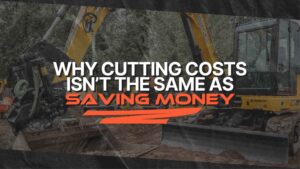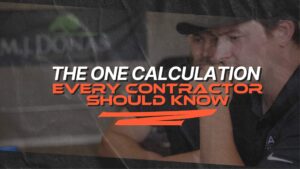What’s the Point of Job Costing?

You’re rolling, growing your business, getting jobs done, making sure the client is happy, and moving on to the next job. You may have come across a Facebook thread where people were touting that you “must” job cost, or you may have seen a free job costing spreadsheet.
So… what’s that even mean?
And why should you spend the precious time you already feel like you don’t have to do it?
Do you know the point of job costing?
Job costing is: the process of taking your original estimates’ numbers and comparing them against the actual numbers when the job’s done.
Typically, it means comparing ‘estimated’ vs ‘actual’ expenses, hours, and profits.
The whole point of job costing is not to geek out over the numbers.
It’s simply to compare estimated vs actual numbers to learn where you went right and where you went wrong on every job.
That’s it.
It’s that simple ….except that it’s not that simple, is it?
Tracking every single expense, tracking all man hours every day, sounds simple enough. But man is it so easy to not get it done. So easy to focus on the production, charge through the job with the pedal to the metal, getting on to the next one.
But if you believe in continuous improvement, learning from your mistakes, and getting better every day, then job costing must be a part of your life.
The point of job costing is to take all your actual hours and expenses after the job is done, hold it up side by side with your original estimate, and scan those numbers.
How close was your original estimate? Does it suddenly become apparent that you didn’t figure enough man hours on that custom seating wall? Or that it took far more time haul out that fill than you thought? Or that this is the 3rd job in a row now where you didn’t have enough stone?
What the point of job costing is not
This is what I mean when I say the point of job costing is not to geek out over the numbers and percentages. It’s to learn REAL LIFE lessons on where you made mistakes on the estimate and give you the knowledge to course correct and be more accurate on the next job. A.k.a actually earning the profit you set out to earn. Because every time you get something wrong on the estimate, guess where it comes from?
Your profit.
And when your profit gets ransacked, you can’t
- make any money
- upgrade your equipment
- pay your guys enough to stick around
you work harder, but your bank balance keeps dropping, and you suffer. …and unfortunately, it’s not just you that suffers. Your team and family do too.
They’re counting on you to make…
- this happens
- it successful
- its something they can build their career on
Not job costing is like shooting at a target, aiming for the bullseye🎯, but then never looking where you hit after the shot.
You could be entirely missing the target, but never know it. You’re not looking.
In real life, you won’t know it until you run out of cash. And by that time, it’s far far more difficult to dig yourself out of that hole.
So again, the entire point of job costing is simply to take your estimate, hold it up against the light of your actual numbers, and ask yourself, what can you learn from it? What should you do differently on the next job? Whether from a production standpoint or from an estimating standpoint. Either way. Both perspectives are valuable lessons that you can learn from job costing.
Your “gut” is not “job costing”
And no, relying on your gut feeling is not job costing. If you just “know” that you made money on this job…. Sorry… you might be right a few times. But you’re also going to be wrong a few times and miss valuable opportunities to learn and course correct. You gotta be able to explain to your 10 year old how and why you made or didn’t make money on that job. Meaning it’s gotta be in black and white, in simple numbers. Estimated vs actual man hours. Estimated vs actual materials. Estimated vs actual equipment. Estimated vs actual subcontractors. Estimated vs actual profit.
To pull this off simply means that you need to track your man hours every day. Keep all your receipts. And track equipment costs.
Sounds simple. And it is simple if you make it a part of your process. Your non negotiable daily habit.
You can do this anywhere
At Tussey Landscaping we did that by paying our crew based on the hours they track. If they don’t track them where we can see which job they worked, no pay. Meaning we aren’t just gonna throw 40 hours on a pay period. We gotta know which jobs those 40 hrs were on.
You can job cost on a napkin, on a spreadsheet, or in an app. I don’t care which one you do, just do one.
In my experience, job costing isn’t hard, once you’ve collected that actual data to job cost. The hard part is collecting the actual data for job costs.
That’s the problem we solve in the SynkedUP mobile app.
Your team uses the app to access job info and track time. All your hours get tracked to a job. Then when they clock out, they get prompted to enter what materials they used that day, and viola, you’ve automatically got the info you need to job cost. We then show you a beautiful estimated vs actual job cost report.
The awesome part of this is not only that you know if you’re doing well on the job, your crew immediately knows as well. And it triggers conversation and retrospect.
“Dude we didn’t have enough hours on that custom inlay! We busted our tail and still went over 30% on the hours”.
Or you get…
a screenshot from your crew lead, “Hey we’re pulling off the job, things went great and we’re done with still 20% of hours left.” 🙌
The point I’m making here is your team is also ‘” in the know”. And when they’re in the know, they’re going to take pride in doing well.
They’re going to be frustrated WITH you when you miss the goal. They’re going to be connected.
Conclusion
The end result is not only the salesperson learning how to be more accurate on the next estimate.
Your entire team is:
- leaning in
- learning in real-time
- making adjustments where it becomes obvious it’s needed
- more successful and profitable because of it
People just have an innate desire to know what’s expected of them and to know when they’re doing well or not – Winning or losing.
And that’s the point of job costing. To know if you’re winning or losing.
It’s far easier than manually collecting paper receipts all the time.
Do you wanna learn more about how SynkedUP does this?
Cheers✌️
Weston

Weston Zimmerman
CEO and co-founder
See SynkedUP in action
Related Articles
Why Cutting Costs Isn’t the Same as Saving Money
Cutting costs isn't the same as saving money. Learn how to use leverage, not panic, to drive real profit and...
Slow Down to Speed Up
A quick leadership gut check: Are you building what really matters? Slow down, realign, and lead with intention.
The One Calculation Every Contractor Should Know
Contractors: If you’re not factoring in overhead, you're not pricing right. Learn how to calculate breakeven and stop guessing your...
What Owns Your Day? Urgency or Importance?
Stuck in a cycle of chaos and urgent tasks? Break the cycle with better systems, clear processes, and leadership that...
Taking Care of Your Team
Leadership isn't barking orders - it's listening, appreciating, and building problem solvers. Here's how to lead without burning out.
The Cost of Avoiding Issues in Your Business
Avoiding stuff in business adds up, with interest. Don't try harder, build systems that make success default. Do hard things,...
Leveraging Your Job Data for More Accurate Estimates
Stop estimating from the gut. Track time, collect job data, and turn it into faster, more accurate production rates.
How the Best Contractors Ensure Profitability
Running over estimated hours is one of the biggest silent profit killers in contracting. Here's how to track it, catch...
How To: Rank Higher on Google Search
Learn how to rank at the top of Google without spending thousands. This simple, free strategy levels the playing field...
Costly Estimating Mistakes Contractors Make
Sanity check your estimates with 3 simple tips that help you avoid undercharging and building in real margin.










